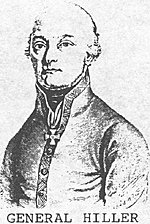
Phase I. Initial phase: Approach by cavalry
A little before 10 AM, Marulaz's cavalry [Gachot, p. 125: Gachot says that Marulaz was instructed to be very careful (surtout, n'allez pas vous aventurer)] first echelon receives some Austrian fire at the Wells crossroads and stops (according to orders). When the Austrian Kienmeyer's division cross the Traun, a rear guard is left behind. With difficulties, the French cavalry push away the groups that Colonel Scharlach CO of the IR Benjowski, had between Muhl stream and the hamlet of Reisebauer. Vincent concentrate his troops: Regiment Spleny rearguard of the Austrians t.iat withdrew from Wels (and crossed the Traun) when Bessiere pushed f<-)rward, Rosenberg Chevaulegers, and IR Klebek. Apparently on e battalion takes position in Klein-Mljnchen and the rest between that village and the bridge.
Marulaz, fearing an ambush, stops between the hamlets of Scharlinz and Hans. (see Phase I Note)
Phase II. French infantry attack of the left side of the river Traun.
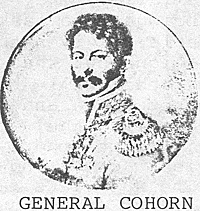 During that time, Claparede, leaving to the cavalry the task to protect his right follows the road to Ebelsberg. He immediately engages Cohorn's [Cohorn, in all the French texts is spelled either Cohorn or Coehorn. Both spellings are acceptable (Davout is sometimes spelled Davoust)] brigade with 3 guns in support. Under the attack of that small force, Spleny and Benjowski hold. Pushed out of Klein-MUnchen they slowly (pas a pas) withdraw toward the Traun. However the 2nd battalion of IR Klebeck, become isolated and surrounded by the cavalry between the Traun and MUhl, had to surrender [Colonel Best's report quoted by Gachot (Vienna War Archives, 5.AD 95): "During our hard march, it resulted that major von Jametz, 14 officers and 315 men became prisonners].
During that time, Claparede, leaving to the cavalry the task to protect his right follows the road to Ebelsberg. He immediately engages Cohorn's [Cohorn, in all the French texts is spelled either Cohorn or Coehorn. Both spellings are acceptable (Davout is sometimes spelled Davoust)] brigade with 3 guns in support. Under the attack of that small force, Spleny and Benjowski hold. Pushed out of Klein-MUnchen they slowly (pas a pas) withdraw toward the Traun. However the 2nd battalion of IR Klebeck, become isolated and surrounded by the cavalry between the Traun and MUhl, had to surrender [Colonel Best's report quoted by Gachot (Vienna War Archives, 5.AD 95): "During our hard march, it resulted that major von Jametz, 14 officers and 315 men became prisonners].
Phase III. French infantry breakthrough.
General Co horn (who had received the order to be careful) seeing the enemy withdrawing in a hurry, jumps on the opportunity to distinguish himself at little cost. Without awaiting for further orders, Cohorn, impatient, follows the enemy.
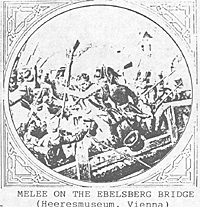 Phase IV. Crossing over of the river Traun, capture of the bridge and of the Ebelsberg Gate.
Phase IV. Crossing over of the river Traun, capture of the bridge and of the Ebelsberg Gate.
On the heels of Benjowski, the Corsican Tirailleurs push back the Austrians (some are reported as pushed in the river), cross over the bridge on the double, arrive at the Ebelsberg door which Lieutenant Seyringer tries to close unsuccessfully. The French chasseurs enter the city. It is 11.30 AM.
Following the Corsican Tirailleurs, the Tirailleurs du Po crossover the bridge, in open order (rangs ouverts), under the fire of an Austrian 8 guns battery located on the right of the castle, and suffer the loss of only 10 to 12 men. Marulaz gives to the 2 battalions the support of an elite company of the 19th chasseurs a cheval. The officers of these 2000 men do not see insuperable obstacles, and after going through the Ens door, quickly push forward toward the Vormark and place a strong contingent in a cemetery on right. The Austrian 4th, 5th and 6th battalions of the Vienna Volunteers lead by Salis and Kuffl counterattack and push back the French in the town and make some prisonners. Kienmeyer reenforces these volunteers.
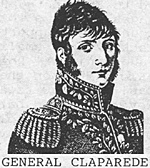 Phase V. Reenforcement of Cohorn's brigade by the two other brigades of Claparede's Division.
Phase V. Reenforcement of Cohorn's brigade by the two other brigades of Claparede's Division.
Claparede has two alternatives! Reenforcing his vanguard or withdrawing it on the left bank. A precipitated retreat would have demoralized the troops. Claparede's two other brigades (Lesuire and Ficatier) were now available. They were ordered across the bridge. The task of assaulting the castle is given the 7th Demibrigade de Ligne but that unit is repulsed. The other Demi -brigades climb to the market place and fight for a short time against the 3 battalions of IR Mitrowski, supported by the 5th and 6th battalions of Archduke Charles regiment. The Austrians fire from the buildings and open fire with a fresh battery of 6 guns kept, so far, in the reserve near the castle. Under heavy fire, the French recoil toward the edges of Ebelsberg and occupy some buildings on the edges of the Traun. There, they hold awaiting help...
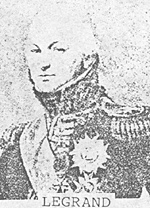 Phase VI. Legrand's Division cross over the Traun and enter Ebelsberg.
Phase VI. Legrand's Division cross over the Traun and enter Ebelsberg.
Massena arrives at Ebelsberg only at noon [According to Gachot, Massena made a mistake in his report when he says that he reached Ebelsberg at 10 AM. (or was ordered to do so by Napoleon to cover Claparede). At 10.30 AM Massena was still in Linz, speaking with Augermer, the Austrian Administrator of that city until 11 AM. At 11.30 AM he is informed that Claparede is going to crossover the Ebelsberg bridge]. There he sees Claparede's precarious position. His first question is: "Why did he put himself in such a mess? (pourquoi s'etre fourr2 dans un pareil guepier?) What to do? Dismount the chasseurs and send them in Ebelsberg over the bridge? One third will be swept away by a battery firing canister. He sent some horsemen to find a ford. The water is some 5 meters deep. Careful, he chooses not to attempt such crossing.
Some Austrians, in an attempt to isolated Claparede, come out from hidding and set afire the last part of the bridge. Two canister discharges force the Austrian sappers to seek cover. Fortunately for Claparede a strong west wind put out the fire. Pernetty send his sappers to get some wood in a nearby sawmill to repare the damages. The guns of Claparede's Division, at 1 PM, are placed on the banks of the Traun. Behind the protection of an embankment, that artillery is going to counterbattery the Austrian battery and prepare the way for the awaited Legrand's Division. A strong Austrian reaction comes quickly. So, Pernetty places in the front of the sawmill 8 more guns commanded by Captain Delpire. Hiller's artillery has to withdraw. Two Austrian howitzer on the right bank of the Traun are dismounted. Most of the Austrian artillery is now neutralized and the bridge is only under the fire of the Austrian infantry occupying the two buildings on the road to Ens.
Legrand's Division is about to arrive. Massena contacts him near the "Chapel" (see map) and orders Legrand as quickly as possible to cross over with his fresh Division and take Ebelsberg. At 2 PM the 18th of the Line, the 26th Leger and the Baden infantry arrive on the Traun and receive double amount of ammunitions and Legrand's Division starts to cross over behind the sappers that have repaired the bridge. Legrand joins Claparede and plans are made.
Phase VII. Capture of the castle
Colonel Pouget of the 26th attacks the castle with his 1st battalion. With some sappers the carabiniers of the 26th reach the castle where a violent firefight takes place. Finally, the accurate fire of some French sharpshooters allows the final assault to take place. Some 200 Austrian grenadiers are captured. The 2nd battalion of the 26th goes back toward the Ens road where the two other battalions of the 18th operate and have rallied what of Claparede's is still able to fight. During that time, the 3rd battalion of the 18th clears the right bank toward Wels and the Baden infantry the left bank.
Massena then sent Ledru's brigade, uptown, with two pieces of 8. Some Austrians find their way to the bridge and set it afire again. Cohorn can limit the damage somewhat and the bridge is once again repaired by the Commandant Flayelle of the genie. That action delayed again the crossing over of the French cavalry which would have been very useful at that point against Hiller's rearguard.
The violent fight in Ebelsberg went on for two more hours. The French setting afire the buildings in which the Austrians were firing from etc. After exhausting their ammunitions, the Austrians withdrew by the Ens' door which they managed to close. That door was blown to pieces by the 8 pounders and the sappers finished to clear it.
VIII. The final phase
By the Ens door, the French troops arrived on a unoccupied plateau on which they reformed. Apparently, the Prince of Reuss, informed that two columns had gone around Ebelsberg and could attack his flanks, withdrew toward the Asten woods. However, Kienmeyer did not want to follow. He pretended to be able to win against the small number of troops he was facing. With two battalions of IR Deutchmeister, the 2nd of Kerpen and some cavalry, he attacked around 7 PM.
The collision was very violent. Legrand did loose some ground. He would have been repulsed in the town without some help that arrived just on time. Massena had with him the Corsican Tirailleurs and two battalions of the 26th Leger. Pernetty followed with his artillery and then came Marulaz's hussars. Durosnel with the cavalry of the land Corps appears in the front of Fishdorf. Kienmeyer is unable to hold this overwhelming force and Hiller orders him to retreat toward the Ens. The rearguard is given to the 2nd battalion of IR Mitrowski and to Knesewich dragoons.
In Ebelsberg the combat from houses to houses kept on going. The Austrians on the 2nd floor, did not expect quarters. It was a combat of extermination in which the civilians suffered as much as the soldiers.
So ended the battle of Ebelsberg. Napoleon was not too happy about the heavy losses and blamed openly Massena for the unnecessary front attack since the position was in the process of being turned by other French troops. Massena, one can argue, was not responsable for Claparede's and Cohorn actions since they disobeyed the orders not to take chances. However, Massena had been informed by Napoleon that if the Austrians were going to make a stand it probably would be at the strong position of Ebelsberg. It's rather obvious that Hiller was not expecting the French to make such an audacious attack on Ebelsberg and consequently he had not taken any really adequate dispositions to counter such a possibility. After the action bagan he did not show much ability to take advantage of his position and large superiority in numbers. If he had been a little aggressive he should have simply annihilated Claparede's command.
An attempt to evaluate the French losses at Ebelsberg is following. Additional notes on several phases of the battle are given below.
Battle of Ebelsberg: 3 May 1809 War Against Austria
Back to Empire, Eagles, & Lions Table of Contents Vol. 1 No. 78
Back to EEL List of Issues
Back to MagWeb Master Magazine List
© Copyright 1984 by Emperor's Headquarters
This article appears in MagWeb.com (Magazine Web) on the Internet World Wide Web.
Other articles from military history and related magazines are available at http://www.magweb.com
